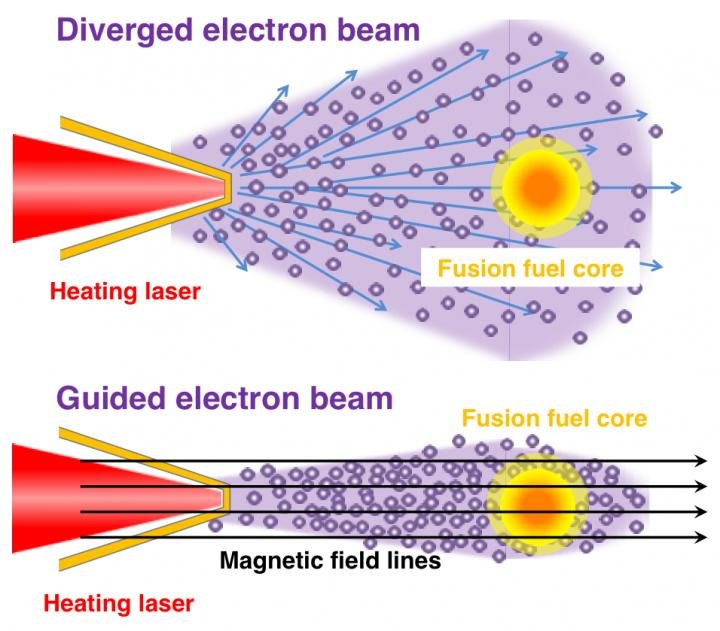
Relativistic electron beam (REB) accelerated by high-intensity laser has a large divergence angle. The REB needs to be guided along the magnetic field lines to the compressed fuel core. Image: Osaka University
An international joint research group led by Osaka University demonstrated that it was possible to efficiently heat plasma by focusing a relativistic electron beam (REB) accelerated by a high-intensity, short-pulse laser with the application of a magnetic field of 600 tesla (T), about 600 times greater than the magnetic energy of a neodymium magnet (the strongest permanent magnet).
Their research results were published in Nature Communications.
If matter can be heated to temperatures of tens of millions of degrees using REB accelerated to nearly the speed of light by irradiating plasma with high-intensity lasers, it will become possible to ignite controlled nuclear fusion reactions.
In the central ignition scheme, a prevailing scheme for inertial confinement fusion (ICF), has the problem of ignition quench, which is caused by the hot spark mixing with the surrounding cold fuel.
On the other hand, in the fast ignition scheme (fast isochoric heating), a portion of low temperature fuel is heated, and then the heated region becomes the hot spark to trigger ignition before said mixing occurs.
Thus, the fast ignition scheme has drawn attention as an alternative scheme.
In the fast ignition scheme, first, fusion fuel is compressed to a high density using nanosecond laser beams.
Next, a high-intensity picosecond laser rapidly heats the compressed fuel, making the heated region a hot spark to trigger ignition. Nuclear fusion releases a large amount of energy by burning the majority of the fuel.
The REB, which is generated by a high-intensity short-pulse laser and accelerated to nearly the speed of light, travels through high-density nuclear fusion fuel plasma and deposits a portion of kinetic energy in the core, making the heated region the hot spark to trigger ignition.
However, REB accelerated by high-intensity lasers has a large divergence angle (typically 100 degrees), so only a small portion of the REB collides with the core.
A kilo-tesla level magnetic field is necessary to guide high-energy electrons at the speed of light, so the researchers employed magnetic fields of several hundreds of tesla.
Because electrons, which are charged and have a small mass, easily move along a magnetic field line, they guided the high energy REB of 1MeV along the magnetic field lines to the core (the fusion fuel of 100 microns or less), achieving efficient heating of high-density plasma. They called the scheme magnetized fast isochoric heating.
In this study, laser-to-core energy coupling reached a maximum of 8 percent. The laser-to-core energy coupling, i.e., the energy deposition rate of REB, depends on the density of the plasma to be heated. In calculation based on the ignition spark formation conditions, the energy deposition rate of REB obtained in this study is several times more than that obtained by the central ignition scheme.
Thus, the researchers conclude that the magnetized fast isochoric heating is very efficient and useful for the development of laser fusion energy.
Senior author Shinsuke Fujioka says, “We have made progress towards the realization of laser fusion energy in cooperation with researchers from home and abroad under the Joint Use/Research Center Project. Our research results will be applied to studies on the reproduction of the core of a star in laboratory simulation and the creation of new matter under extreme environments.”
The article, “Magnetized Fast Isochoric Laser Heating for Efficient Creation of Ultra-High-Energy-Density States,” was published in Nature Communications.
Source: Osaka University


